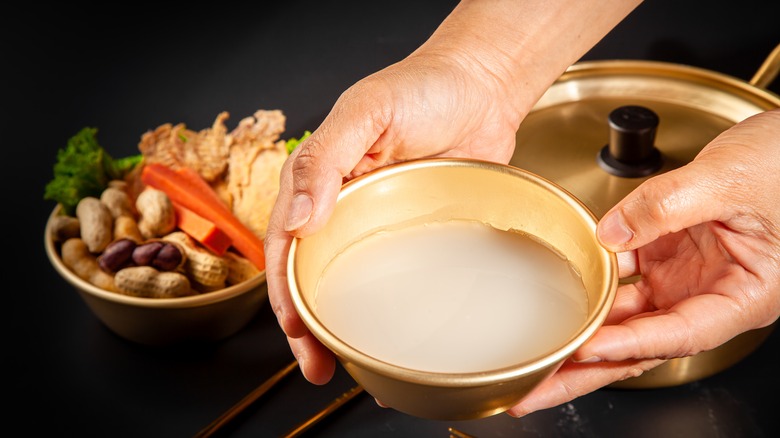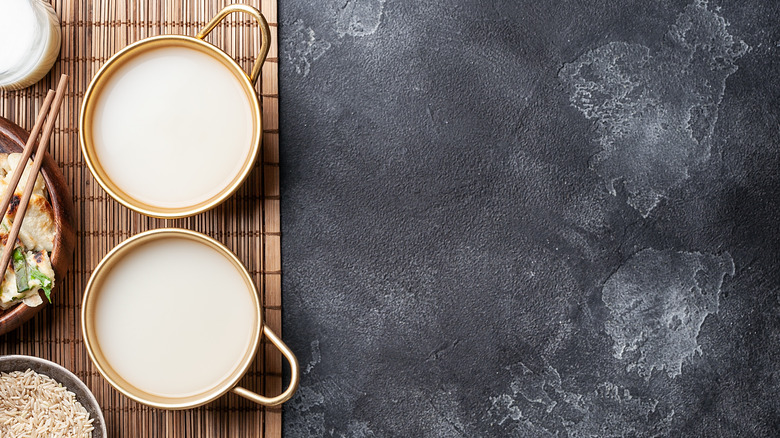Korea's Oldest Alcoholic Beverage Is Coming Back To Life In The US
Move over espresso martini and Aperol spritz, a 2,000-year-old drink is rising among the ranks of alcoholic beverages in the United States. For many people, soju is probably the more recognizable alcoholic drink from Korea. While soju, a fermented rice liquor, is considered the hip, young cousin in the drink world, makgeolli has been disregarded in Korean society as an old, outdated relative. But it's making a comeback.
Makgeolli is an alcoholic wine primarily made from rice. Unlike soju and other liquors, makgeolli is typically unfiltered, resulting in its milky-white color and thick viscosity. The fermented drink has exploded in popularity thanks to several small U.S. businesses and brands. Sool, a U.S.-based company, is just one of those many brands. Carol Pak, founder of Sool, told Forbes she wanted to end the drink's stigma of being a drink of the past and reintroduce it in the U.S. to a younger crowd through Makku, her take on makgeolli. "There could be an interesting space for makgeolli," she said in 2020, "especially since there was this rise of Korean culture that we've been seeing influence America in the realm of beauty, food and K-pop."
Makgeolli's rebrand in America
Makgeolli's rise to fame didn't happen overnight. Small businesses and restaurants across America have been making and selling the fermented wine for several years. New York City's Take 31 and Chicago's Slow City Brewery both brew makgeolli in-house. It also has been available in liquor and grocery stores within Korean American communities.
There's also now a chance for businesses to highlight makgeolli's traditional fermentation process. Makgeolli is typically made with rice, water, and nuruk, which is a grain cake used for fermentation. Nuruk helps turn the starch in rice into simple sugars and, eventually, alcohol. The entire process usually takes about a week.
U.S. brands like Makku have adapted makgeolli for American consumers, pairing the drink with fruity flavors such as mango and blueberry. Some bars, such as NYC's Reception Bar, incorporate makgeolli into cocktails, enhancing the Korean drink with splashes of lemon and honey, as well as cinnamon and dulce de leche, to make a horchata-inspired cocktail. Makgeolli has even gone beyond restaurants; it's sold now sold at Whole Foods and bodegas, according to Liquor. Forbes even called the liquor the "Next Alcohol Trend To Watch" back in 2020.
The drink is also having a moment in Korea
The United States isn't the only country having a moment with makgeolli. Once ignored by Korea's society, makgeolli is also having a resurgence among the younger generations in its home country. The rice wine was often written off as a "poor people drink," Sool and Makku founder Carol Pak told Matador.
While makgeolli has been made and drunk for thousands of years, the ban on rice in alcohol production in 1965 led to a decrease in the consumption of the drink. Soon, it was replaced by alcoholic drinks made from sweet potatoes and barley, which gave way to the rise in drinks like soju. Soon makgeolli became a thing of the past, but just like here in the United States, small businesses and innovators in Korea are reintroducing the drink to a younger crowd.
Breweries in Korea are marketing the drink to appeal to young generations by bottling makgeolli in minimalist packaging and designs, according to South China Morning Post, while elevating and keeping the traditional integrity of the drink. Bars and speakeasies are adding makgeolli into spirits and cocktails, as well.


